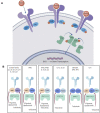Promising Treatment Options for Axial Spondyloarthritis: An Overview of Experimental Pharmacological Agents
- PMID: 34257507
- PMCID: PMC8269276
- DOI: 10.2147/JEP.S262340
Promising Treatment Options for Axial Spondyloarthritis: An Overview of Experimental Pharmacological Agents
Abstract
Axial spondyloarthritis (axSpA) is a chronic inflammatory condition that predominantly affects the axial skeleton. All patients receive conservative management measures which include physiotherapy, patient education and use of nonsteroidal anti-inflammatory drugs (NSAIDs). Those with significant active disease will require escalation of their treatment with the use of biologics. Currently, there are five approved TNF inhibitors and two approved IL-17 inhibitors for use in axSpA. However, despite this up to 40% of patients do not respond or are intolerant to current available treatment. This leaves a significant number of patients with uncontrolled disease and unmet need for additional therapies. Though many drug classes have been trialed for axSpA they show poor efficacy; however, over the last few years there are three which demonstrate much greater promise as novel therapies for axSpA, these include dual neutralization of IL-17A and IL-17F, Janus kinase (JAK) inhibitors, and granulocyte-macrophage colony-stimulating factor (GM-CSF) inhibitors. This article reviews the evidence for these novel emerging therapeutic options for axSpA.
Keywords: Axial spondyloarthritis; GM-CSF inhibitors; IL-17 inhibitors; JAK inhibitors; novel therapies.
© 2021 Tahir et al.
Conflict of interest statement
The authors report no conflicts of interest in this work.
Figures

References
Publication types
LinkOut - more resources
Full Text Sources

